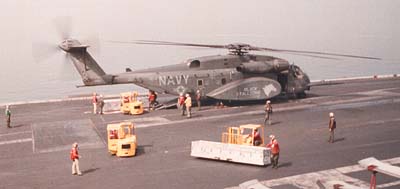Ray Holden and Ron Reed, members of NAWCWD's Joint Standoff Weapon (JSOW) IPT, recently returned from a whirlwind week aboard USS Kittyhawk in the Persian Gulf.
The JSOW team members (Holden is from Point Mugu and Reed works at China Lake) were on a mission in direct support of Kittyhawk's military readiness. Their task - performed at the request of PMA-201 - was twofold.
First, they were to reprogram a shipment of JSOWs so that the weapons would be fully compatible with the F/A-18 aircraft squadrons stationed aboard Kittyhawk. At the same time, they needed to train and certify ship and squadron maintenance workers on JSOW programming procedures and in proper loading and handling of the weapon.
Getting to the ship was in itself a project. On short notice, the 4.7 and 4.9 competencies arranged for all the required paperwork - site and security clearances, briefings and the like. "The support from our organizations in getting Ray and Ron ready for foreign travel was absolutely fantastic," said Scott Weed, JSOW IPT lead. "This level of assistance helps us provide essential and timely support to the fleet."
Then it was hurry up and wait. The trip had to be timed so that the two men arrived just before the JSOWs came aboard Kittyhawk. One shipment of weapons was coming from an ammunition depot in Oklahoma, and the other contained weapons being transferred from USS Carl Vinson. The delivery schedule for the JSOWs, however, was classified.
Finally, Holden and Reed received a specific arrival date, were given their travel orders and set off for the Near East. An 18-hour flight from LAX via London took them to Manama, capital of the State of Bahrain. Manama also hosts the headquarters of the U.S. Central Command's naval component and U.S. Fifth Fleet.
Shortly after arrival, Holden and Reed climbed aboard a C2 Greyhound transport aircraft and, in less than an hour, made a "trap" landing on the deck of Kittyhawk. Each man carried a PCMCIA/CardBus containing the all-up-round codes for JSOW, a critical element in tailoring the JSOW software to Kittyhawk's F/A-18 fighter squadrons.
Commissioned in 1961, Kittyhawk is the oldest active ship in the Navy. Part of Carrier Air Wing FIVE, the ship and her crew of 5,500 are in the Gulf to support Operation Southern Watch, which is enforcing the no-fly zone over southern Iraq. Among the nine aircraft squadrons assigned to Kittyhawk are three F/A-18 squadrons: VFA-27, -192, and -195.
"F/A-18 squadrons can use different operational flight programs," explains Weed. "Kittyhawk's aircraft use OFP 13C. Part of Ray and Ron's task was to configure the JSOWs being transferred from the Carl Vinson the same as the weapons arriving from Oklahoma, which used the best JSOW software for OFP 13C."
Ray Holden oversaw the actual loading of the software. "We were using a new piece of equipment called the CMBRE [Common Munitions Built-in-test Reprogramming Equipment], which we've been jointly developing with the Air Force," said Holden. "It's designed to be used with several weapons now in development, including JDAM, AIM-9X and JASSM."
While Holden was working on the weapons, Reed was training and certifying the squadron's and ship's personnel who would be working with JSOW. "These were the first JSOWs on Kittyhawk," Reed observed. "Everyone had heard about the weapon, and they were excited to be working with it."
The training syllabus was complex, covering both organizational and intermediate level maintenance and operations. The squadron crews were trained on how to load and test the weapon. The intermediate-level personnel were taught how to break out the weapon, inspect it and deliver it for loading. The Sailors were also instructed in how to maintain and configure the support equipment.
For nearly a week Holden and Reed worked with the weapons and crew. A carrier never sleeps, and the two men often put in 18 hours at a stretch. They trained about 300 people and reprogrammed all the weapons. Finally, the task was done and they were ready to return to Manama. Then there was a glitch.
"The C2 Greyhounds had just begun a no-fly period to coincide with a Bahraini holiday," said Reed. "It looked like we were going to be stuck aboard for two more days."
When Capt. Tuohy, Kittyhawk's skipper, heard of their predicament, he ordered the ship's helicopter made ready. The men were then flown back to Manama and soon were on a commercial flight headed stateside.
Holden's daughter, Halie, sent a note to Tuohy thanking him for the special attention he'd shown her father. By return mail, Tuohy sent the 9-year old girl a photograph of Kittyhawk. On it he had written, "Thanks for lending us your dad."
-END-


